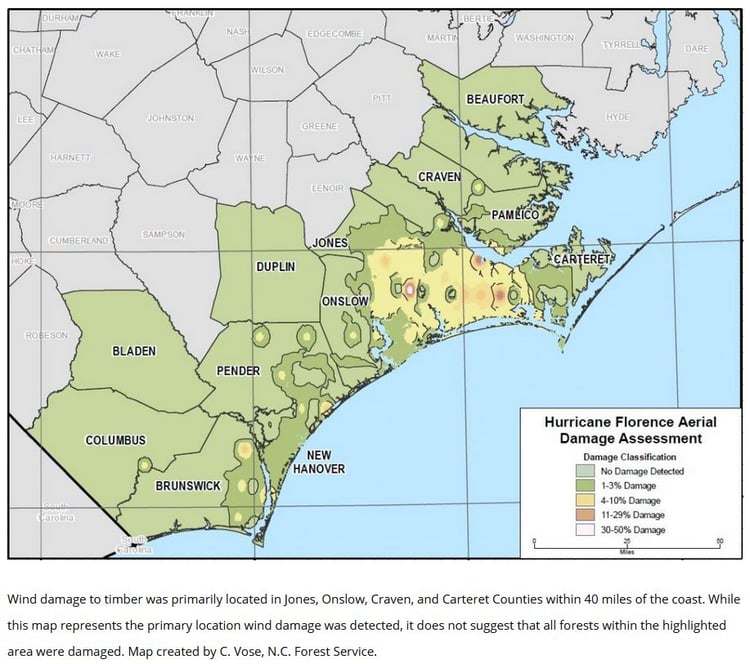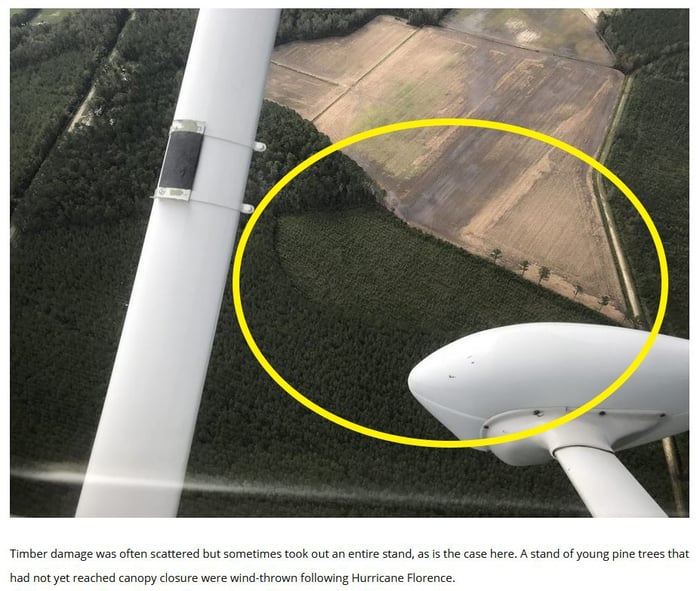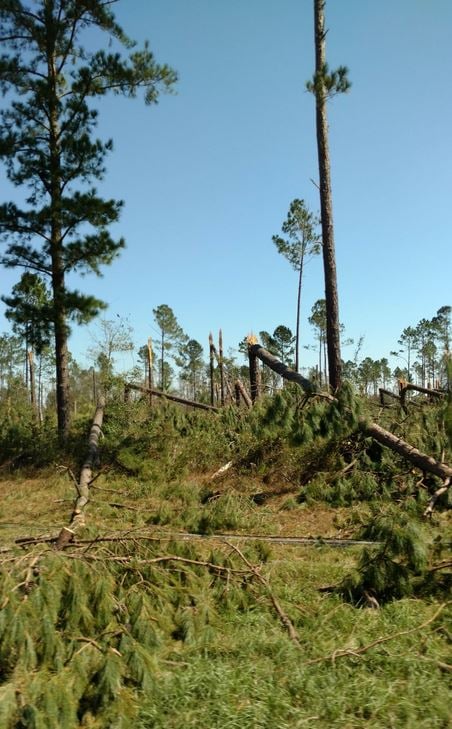3 min read
Surveying Timberland Damage in the Wake of Major Hurricanes
John Greene
:
October 19, 2018

While we don’t yet know the full extent of the destruction that Hurricanes Florence and Michael caused across the southeastern US, it is clear that both storms inflicted massive human and environmental damage that will likely cause fallout for many months, if not years. Both storms also caused significant damage to the region’s agriculture industry, including its dense stands of pine timberland.
In the coming weeks, we will monitor the latest damage reports as well as the market response to these two storms, and provide updated, relevant analysis as the data becomes available.
If you would like to read some of our other published content on this topic, please visit the links below:
- How Have Recent Gulf Coast Hurricanes Affected Stumpage Price?
- Timberland Management in the Wake of a Natural Disaster
- Precipitation Event Impacts: Shifts in Wood Supply & Procurement Patterns
- Precipitation Event Impacts: The Relationship between Haul Distance & Supplier Margin
- Precipitation Event Impacts: Mill Inventories & Delivered Price
What do we know thus far regarding the total damage from Florence and Michael?
Hurricane Florence
Hurricane Florence approached from the Atlantic Ocean as a very slow-moving, soaking category 1 storm and made landfall in southeastern North Carolina. The storm brought wind gusts of over 100 mph and record-breaking rainfall that totaled more than 40” in areas. A recent estimate by NC State University notes that Florence caused “over $70 million in significant damage to forest and timber land through wind and flooding.”
The North Carolina Department of Agriculture & Consumer Services published updated information via its “In the Field” blog from October 1, in which N.C. Forest Service aerial surveyors assessed local timber damage by aircraft. Based on the locations of the strongest winds, the surveyors flew in horizontal paths 10 miles apart from the southern tip of the state to the Pamlico Sound, and they searched for trees that were uprooted/fallen, or trees that suffered significant breakage.
The blog post notes that “Over two days, the aerial surveyors mapped 161 points in categories based on amount of damage, type of damage, and type of trees. While localized wind damage occurred throughout the Coastal Plain, the heaviest timber damage appeared in Craven, Carteret, Onslow, and Jones Counties within 40 miles of the coast.”
 SOURCE: North Carolina Department of Agriculture & Consumer Services
SOURCE: North Carolina Department of Agriculture & Consumer Services
The post adds that “Forest edges suffered the greatest impact. In addition to downed and broken trees throughout the Coastal Plain, hardwood trees had sparse foliage on the windward side because of high sustained winds.” In all, an estimated 1,251,312 acres of forestland received some level of damage.
 SOURCE: North Carolina Department of Agriculture & Consumer Services
SOURCE: North Carolina Department of Agriculture & Consumer Services
While the wind damage (similar to the damage seen in the image above) is most obvious, the impact from the extreme rain and flooding can have long-term effects, and it’s simply too early to tell what areas will be affected by water. Southern pine trees are resilient to moderate flooding, however, the long-term effects and full extent of the flood damage is yet to be determined.
Hurricane Michael
Fresh on the heels of Florence, Hurricane Michael developed quickly in the Gulf of Mexico and slammed directly into the panhandle of Florida as a Category 4 storm before moving northeast and cutting a swath of destruction through portions of Georgia and the Carolinas. Michael was a unique storm for the region in many ways:
- Michael became the first Category 3 hurricane to hit Georgia since 1898.
- Only three major hurricanes made landfall in the Florida panhandle since 1950 before Michael: Eloise in 1975, Opal in 1995 and Dennis in 2005.
- Michael, with 155 mph winds at landfall, is the strongest storm to make landfall in the continental US since Hurricane Andrew in 1992.
CNBC notes that the agricultural damage from Michael may top $1.3 billion. While cotton and pecan farmers suffered the brunt of the destruction in Alabama and Georgia, estimates are that Florida alone lost over 3 million of its 17 million acres of timber, a vast majority of which are working forests. An immediate loss of 18% of the state’s working forests could be devastating to Florida’s forest products supply chain both in the near and long terms.

As Hurricane Michael traveled through Jackson County, Florida, acres and acres of pine trees received some sort of damage from the winds. SOURCE: Michele W. Forehand/Dothan Eagle
In response to the storm, Florida Commissioner of Agriculture Adam Putnam said, "We'll continue to do everything we can to help Florida agriculture recover from this catastrophic hurricane." The Florida Forest Service Information Officer, Annalisa Winter, confirmed that additional forestry teams are on site to determine the full extent of the damage to the timber crop following Michael. “This is going to take some time,” Winter said. “At this time, we can’t provide accurate information on what timber will be harvestable or what timber amounts could be a complete loss.”
Several programs are available to assist with replanting, though an assessment must be completed to determine the damage. Once the assessment is complete, a forestry agent will direct timber owners to available programs, Winter added.





